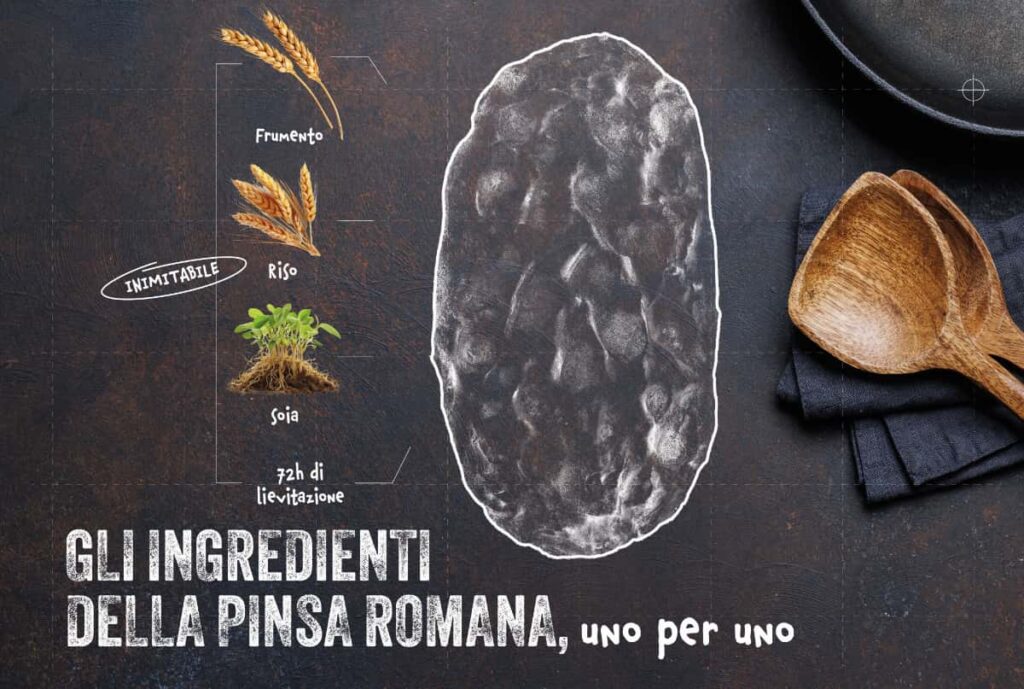We have often focused on how to maximize the value of pinsa, creating excellent dishes for various occasions, from aperitivo to quick lunches in the office, and even dinners among friends. However, it is not really the recipes that make pinsa extraordinary and contribute to its success, as they are similar to those of pizza or focaccia. The true strength lies in the pinsa itself, its ingredients, and its processing method, which make it an iconic, tasty, digestible, and versatile dish. In this analysis, we aim to understand why, by focusing specifically on the ingredients of pinsa.
The ingredients of pinsa: it all starts with flour (and water)
An article about pinsa ingredients must begin with flour, which is responsible for much of the structure, taste, lightness, and digestibility of the product. As it is well known, unlike other baked goods, pinsa is not based on a single type of flour but rather on a mix of three: wheat, soy, and rice. The question is legitimate: why three? In 2001, Corrado Di Marco decided to create a product that was unique and innovative; he was aware that only these two characteristics would make it competitive in a market dominated by an icon like pizza. In other words, differentiation was essential, but not in a trivial way; it was necessary to go beyond a mere change of shape, which remains one of the distinctive elements of the product today.
In 2001, Corrado Di Marco’s intuition was to focus on the ingredients of pinsa, which account for 90% of the final result and align it more (compared to pizza) with the food trends of the time, which began to favour products that were not only tasty but also light, digestible, and with a lower caloric intake. After different experiments, it became clear that this result could be achieved not only with a well-defined recipe, the right yeast, the proper timings and correct hydration, but especially with a well-defined mix of flours.
The three flours of pinsa: what does each contribute?
The dough that gives rise to Pinsa Di Marco is based on three flours: wheat, rice, and soy, blended in the right way.
- Wheat flour is the key element of the product, and it is responsible for much of its taste and lightness; one of its characteristics is the ability to retain water in the dough, thus allowing the development of the airy texture that makes pinsa light and fluffy.
- Soy flour, on the other hand, is very light and has a high protein and fibre content, in addition to being gluten-free. It makes the product nutritious and tasty, avoids the use of animal fats, and has also a lower glycaemic index than other flours.
- Rice flour, besides being low in fats, can capture water that would otherwise evaporate. It is thus responsible for one of the key characteristics of pinsa: the soft inside and crispy outside.
How important is hydration?
Water plays a fundamental role in forming the gluten mesh and hydrating the starches in the flour. It is a key element in all baked goods, including pinsa.
In Pinsa Di Marco, the hydration level (the ratio of flour to water in the dough) is particularly high compared to other products (80%), resulting in a softer, more elastic, and easier-to-process product. High hydration gives pinsa a series of benefits, starting with greater lightness, but it also positively impacts digestibility; such doughs require longer rising times, promoting a slow leavening that makes the final product more digestible.
The key role of sourdough
For the dough’s rising, which takes up to 72 hours, Pinsa Di Marco uses mother dough or sourdough, a natural leavening agent made from a mix of water and flour and fermented with live microorganisms such as yeasts from the raw materials and lactic acid bacteria. Sourdough has a millennia-old tradition, it is considered a healthier alternative to brewer’s yeast, and imparts a artisanal, genuine character to the product, along with a distinctive aroma and airy texture. Sourdough also ensures good digestibility and facilitates the absorption of essential nutrients such as minerals and vitamins.
A pinch of salt and a drizzle of oil
It is impossible to conclude an analysis of the ingredients of pinsa without mentioning salt and oil. Salt, in particular, not only enhances the flavours of the other ingredients but also plays a key role in strengthening the gluten mesh, improving the structure and texture of the dough. Oil, strictly extra virgin olive oil (EVO), adds a touch of softness and flavour to the dough, facilitating its processing and enriching its aroma.










